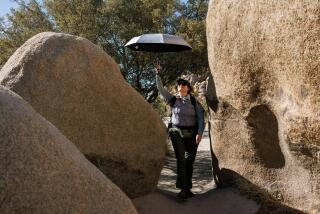No Handicap for Ranger : Naturalist Wheels, Deals on Park Trails
- Share via
ROCKY MOUNTAIN NATIONAL PARK, Colo. — Sometimes, when Michael Smithson shows up to lead a nature walk in the Alpine tundra, he knows his audience is watching him more closely than they might watch another National Park Service naturalist.
“I see a lot of hidden surprised faces,” he says with a grin. “Oh, I guess they’re not so hidden. And no one ever says anything.”
Then, he adds delightedly, the visitors “find they have a hard time keeping up with me. It’s not long before they forget that I’m in a wheelchair.”
Sports-Style Chair
And so he is. It’s a lightweight, sports-style wheelchair, the sort that wheelchair athletes use for basketball and tennis. It’s the only one Smithson uses.
When he guides tourists by the fragile tundra plants, he says: “I just roll around the flowers.”
“Sometimes people will say: ‘You ought to have a motor.’ ” Holding up his hands and grinning again, Smithson says: “I tell them I have two motors, and I need the exercise.”
Smithson’s duties as naturalist for Rocky Mountain National Park’s north district include many nature walks and responsibility for all the park’s official photography. He has worked his way up from supervising the park’s dispatch center over nine years and five different jobs.
Regional Winner
This year, the 33-year-old naturalist was named the Interior Department’s Handicapped Employee of the Year and was the regional winner of a competition that recognizes the best among the Park Service’s interpreters--those who help the public get the most from their national lands.
It’s a long way from the day in 1975 when he took an 80-foot fall out of a tree at Nisqually-Delta National Wildlife Refuge in Washington state. A recent wildlife biology graduate on assignment to study birds of prey, Smithson thought he would have to start all over again finding a way to earn a living.
“After I fell, I didn’t think anyone would hire me to do active research in the field,” he says.
Museum Work
Smithson went into training for museum work at the University of Colorado. En route to his second year of classes at the university, he and a friend were driving through Rocky Mountain National Park when a motorcyclist crossed the center line.
The cyclist died in the accident, but Smithson and his friend were only badly shaken. A park ranger took them home for lunch, then helped them find a room for the night.
“We started talking, and he knew my professor at CU. I told him my background, and he asked if I had ever considered the Park Service.
“Six months later, he called and said there was an opening.”
Children’s Questions
Occasionally, children will ask Smithson why he’s in the wheelchair. He tells them.
Less often, park visitors walk over and start pushing the chair, trying to be helpful.
“People from foreign countries like to ‘help’ the most,” he says. He tries not to embarrass anyone when he asks them to stop.
Mostly, though, the Park Service uniform of gray shirt and green pants makes the difference in how people treat him, he thinks. “They see that more than the wheelchair.”
Smithson is married to a woman he has known since college. They have an adopted daughter and hope to adopt a son too. He misses being able to “just get up and walk somewhere,” but the injury has made little difference in his love of the outdoors.
“Before I fell, I was a rock climber. There’s very little besides that that I don’t do now.”
Altitude Sickness
The tundra areas that are part of Smithson’s territory lure visitors to an altitude of 12,000 feet. Each summer season, a number of visitors suffer altitude sickness or chest pains that require oxygen.
If Smithson finds himself at the scene, he lifts himself from his chair and goes to work.
He has hiked the park’s trails, using crutches and leg braces. He rides horseback to see areas that would be off-limits in his chair.
A focal point of “Rocky,” as this park is known, is Long’s Peak, the highest point along Colorado’s Front Range. It’s a challenge that annually lures thousands of would-be adventurers--and many don’t make it to the 14,255-foot summit.
In September, Smithson made it all the way up the north face of Long’s Peak, a project he had daydreamed about for years.
Used ‘Scooter’
He used a horse to reach the boulder field at the 13,000-foot level, then pulled himself up the rest of the way while sitting in a glass fiber shell--a “scooter,” he calls it.
Smithson planned the late-season expedition specifically to avoid lightning storms, but he still ran into snow and ice along the way.
It was an outing with two friends, like so many others undertook this season, but it took Smithson 27 hours to go up and nine hours to come down--more than twice as long as some might be able to manage.
Smithson doesn’t mind talking about his disability. He will tell you he prefers “disabled” to “handicapped.” But he always cautions people not to generalize about others in wheelchairs because of what they see him do.
“There are all kinds of reasons--injuries--that can put you here,” he explains. “I broke a vertebra low in my back, and I have a lot of movement left.
“Every case is different.”
More to Read
Sign up for The Wild
We’ll help you find the best places to hike, bike and run, as well as the perfect silent spots for meditation and yoga.
You may occasionally receive promotional content from the Los Angeles Times.






